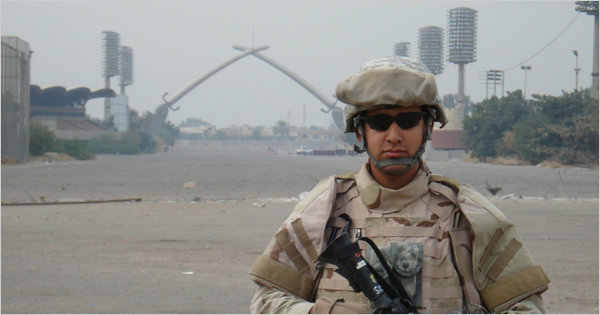New York Times
By JAMES DAO, BENEDICT CAREY and DAN FROSCH
Published: February 12, 2011

PAIN AND DEPRESSION Senior Airman Anthony Mena in Baghdad in 2007. After his death in 2009, a toxicologist found eight prescription medications in his blood
In his last months alive, Senior Airman Anthony Mena rarely left home without a backpack filled with medications.
He returned from his second deployment to Iraq complaining of back pain, insomnia, anxiety and nightmares. Doctors diagnosed post-traumatic stress disorder and prescribed powerful cocktails of psychiatric drugs and narcotics.
Yet his pain only deepened, as did his depression. “I have almost given up hope,” he told a doctor in 2008, medical records show. “I should have died in Iraq.”
Airman Mena died instead in his Albuquerque apartment, on July 21, 2009, five months after leaving the Air Force on a medical discharge. A toxicologist found eight prescription medications in his blood, including three antidepressants, a sedative, a sleeping pill and two potent painkillers.
Yet his death was no suicide, the medical examiner concluded. What killed Airman Mena was not an overdose of any one drug, but the interaction of many. He was 23.
After a decade of treating thousands of wounded troops, the military’s medical system is awash in prescription drugs — and the results have sometimes been deadly.
By some estimates, well over 300,000 troops have returned from Iraq or Afghanistan with P.T.S.D., depression, traumatic brain injury or some combination of those. The Pentagon has looked to pharmacology to treat those complex problems, following the lead of civilian medicine. As a result, psychiatric drugs have been used more widely across the military than in any previous war.
But those medications, along with narcotic painkillers, are being increasingly linked to a rising tide of other problems, among them drug dependency, suicide and fatal accidents — sometimes from the interaction of the drugs themselves. An Army report on suicide released last year documented the problem, saying one-third of the force was on at least one prescription medication.
“Prescription drug use is on the rise,” the report said, noting that medications were involved in one-third of the record 162 suicides by active-duty soldiers in 2009. An additional 101 soldiers died accidentally from the toxic mixing of prescription drugs from 2006 to 2009.
“I’m not a doctor, but there is something inside that tells me the fewer of these things we prescribe, the better off we’ll be,” Gen. Peter W. Chiarelli, the vice chief of staff of the Army who has led efforts on suicide, said in an interview.
Growing awareness of the dangers of overmedicated troops has prompted the Defense Department to improve the monitoring of prescription medications and restrict their use.
In November, the Army issued a new policy on the use of multiple medications that calls for increased training for clinicians, 30-day limits on new prescriptions and comprehensive reviews of cases where patients are receiving four or more drugs.
The Pentagon is also promoting measures to prevent troops from stockpiling medications, a common source of overdoses. For instance, the Navy, which provides medical care for Marines, has begun pill “give back” days on certain bases. At Camp Lejeune, N.C., 22,000 expired pills were returned in December.
The Army and the Navy are also offering more treatments without drugs, including acupuncture and yoga. And they have tried to expand talk therapy programs — one of which, exposure therapy, is considered by some experts to be the only proven treatment for P.T.S.D. But shortages of mental health professionals have hampered those efforts.
Still, given the depth of the medical problems facing combat veterans, as well as the medical system’s heavy reliance on drugs, few experts expect the widespread use of multiple medications to decline significantly anytime soon.
The New York Times reviewed in detail the cases of three service members who died from what coroners said were toxic interactions of prescription drugs. All were classified accidents, not suicides.
Airman Mena was part of a military police unit that conducted combat patrols alongside Army units in downtown Baghdad. He cleaned up the remains of suicide bombing victims and was nearly killed by a bomb himself, his records show.
Gunnery Sgt. Christopher Bachus had spent virtually his entire adult life in the Marine Corps, deploying to the Middle East in 1991, Iraq during the invasion of 2003 and, for a short tour, Afghanistan in 2005. He suffered from what doctors called survivor’s guilt and came back “like a ghost,” said his brother, Jerry, of Westerville, Ohio.
Cpl. Nicholas Endicott joined the Marines in 2003 after working as a coal miner in West Virginia. He deployed twice to Iraq and once to Afghanistan, where he saw heavy combat. On one mission, Corporal Endicott was blown more than eight feet in the air by a roadside bomb, medical records show. He came home plagued by nightmares and flashbacks and rarely left the house.
Given the complexity of drug interactions, it is difficult to know precisely what killed the three men, and the Pentagon declined to discuss their cases, citing confidentiality. But there were important similarities to their stories.
All the men had been deployed multiple times and eventually received diagnoses of P.T.S.D. All had five or more medications in their systems when they died, including opiate painkillers and mood-altering psychiatric drugs, but not alcohol. All had switched drugs repeatedly, hoping for better results that never arrived.
All died in their sleep.
Read the rest of the article here: http://www.nytimes.com/2011/02/13/us/13drugs.html?_r=1&pagewanted=all

